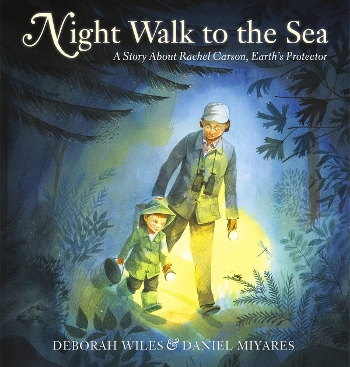I read the illustrations of Night Walk to the Sea several times before I read the words, and everything’s there in the images. The ink is alive in Miyares’s hands, these images at once glowing and calming. But let's also talk about the Caldecott criterion “excellence of presentation in recognition of a child audience.”
 You need to have this book in your hands.
You need to have this book in your hands.
Author Deborah Wiles imagines this story based on some of ecologist Rachel Carson’s writings and her relationship with her nephew Roger, whom she raised after his mother’s death. Roger is frightened when the lights go out on a stormy night, but Rachel is there to calm him. After the storm lifts, she takes Roger for the titular walk to the sea, their flashlights and the bioluminescence of fireflies and ocean life creating light and safety in the darkness.
I read the illustrations of this book several times before I read the words, and everything’s there in the images. It begins with the golden yellow endpapers telling us what to focus on in the pages ahead. On the page-turn, we have contrast in the title page image, black night with a tiny bit of yellow light shining out from a cabin window. The next page-turn, the first full spread, zooms us in so we’re standing outside the window, larger now but still smaller than the stormy world outside. The cabin’s filled with light, a worried boy, and a reassuring, calm woman overseeing the whole scene. The next spread takes us indoors to an image of exuberant, saturated, playful brightness. Rachel and Roger are rendered in detail, while everything else is sketched just enough to be recognizable. All that matters is these people and this relationship.
Look at how skillfully Miyares visually leads us into the story, plot, and theme. Look at the way light moves through this book like a spotlight on a stage, illuminating scenes, yes, but also giving structure to compositions, creating mood, and showing readers what’s important. His composition and use of color are so flawless they’re hardly noticeable, so steeped as they are in communicating the story.
And let’s look more closely at these ink on paper paintings. My favorite is the spread in which Roger and Rachel enter the woods, such a beautiful depiction of night. The light from their flashlights cuts a diagonal through the image, diffusing out into the forest, illuminating outlines of ferns, grasses, rocks, and trees. It has just rained, and we see light shimmer on drops of water still clinging to the leaves. The ink is alive in Miyares’s hands, these images at once glowing and calming.
[Read the Horn Book Magazine review of Night Walk to the Sea here]
Let’s talk about the Caldecott criterion “excellence of presentation in recognition of a child audience.” The art here serves the story perfectly; it’s technically excellent. It speaks sensitively and effectively to an important developmental milestone, learning how to master fear. If I were on this year’s Caldecott committee, I could see myself writing up a vigorous nomination of this book. But also every Caldecott committee member will grapple with how much to divorce text from art, the world from art, our own biases from art. And this is why I want to tell you that I live about a mile from where earlier this year, police officers assigned to protect our community killed a Black man named Daniel Prude, while he lay naked in need of help on a snowy night in the middle of a quiet city street. I know that for the bulk of the child audience in my neighborhood, the notion of venturing without fear into the night, as Roger does in this book, is foolhardy beyond consideration. In 2020, I find myself contemplating “recognition of a child audience” more deeply. Many suburban children living in a world of social distancing can find this book a comforting reminder of primary values and the joy and comfort one can take in the natural world. Most children who live in the country, children like I once was myself, know this before they know how to speak. Here on my block, we have fireflies in abundance every summer, and I seldom see children out even at dusk enjoying that magic. This is not a condemnation of this lovely book, but a recognition that when we start talking about “the most distinguished,” we need to think hard about what that means and for whom.
The best thing about writing for Calling Caldecott is that I can bring up these thoughts and leave them in question state, allowing myself time and space to come to my answers. God bless the 2021 Caldecott Committee, who are, I am sure, quietly freaking out every day asking themselves these same things. I hold Night Walk to the Sea close to my heart, and I submit the question to you: What child audience should the Caldecott serve?

ALREADY A SUBSCRIBER? LOG IN
We are currently offering this content for free. Sign up now to activate your personal profile, where you can save articles for future viewing.








Add Comment :-
Be the first reader to comment.
Comment Policy:
Comment should not be empty !!!